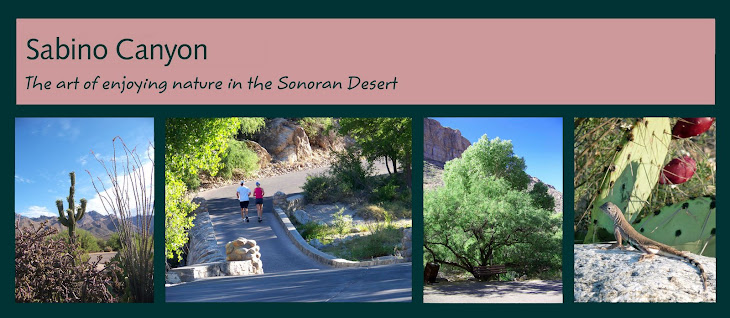In a small way, some of my photography attempts end up being serendipitous to me as a beginning naturalist. This probably happens to others as well. Some of the pictures I shoot turn out to be blurry or have other problems. But while trying to focus on one thing, I have unknowingly captured something else that I can learn from.
For example, while walking home from Sabino Canyon one evening, I took this picture of an agave in a front yard, because I liked its shadows.
 The next day when analyzing the photo, I was shocked to see the rattlesnake. In the picture below, I colored the snake pink to make it easier to see.
The next day when analyzing the photo, I was shocked to see the rattlesnake. In the picture below, I colored the snake pink to make it easier to see. Western Diamondback Rattlesnake Crotalus atrox
Western Diamondback Rattlesnake Crotalus atroxThis is a timely reminder that rattlesnakes are active around here and to be extra careful where we step.
 When cropping the flower image later, I discovered this spider hiding under the flower. This was an exciting find for me because I had never seen this kind of spider before. Again, the bonus animal is painted pink for visibility.
When cropping the flower image later, I discovered this spider hiding under the flower. This was an exciting find for me because I had never seen this kind of spider before. Again, the bonus animal is painted pink for visibility. Flowering Crab Spider or Goldenrod Spider Misumena vatia
Flowering Crab Spider or Goldenrod Spider Misumena vatiaHere are some facts I gathered about crab spiders: They are so named because of their long front legs and their ability move sideways like crabs. They will feed on butterflies, flies, and grasshoppers, but bees are their favorite food. The crab spider does not make a web or use silk to catch its prey. It just sits on a flower and waits for the victim. Then it grabs it with its front legs, bites with its fangs to inject immobilizing venom, then sucks the prey dry. The female lays her eggs on a leaf, rolls it up into an ice cream cone shape, and sews it shut with silk. To blend in, the crab spider can change color from white to yellow but it takes 2-3 days. All crab spiders have eight eyes.
 Later, looking closer at the picture, I noticed the tree lizard blending in with the mesquite tree bark. The lizard pictured below is highlighted with purple to help it to show up.
Later, looking closer at the picture, I noticed the tree lizard blending in with the mesquite tree bark. The lizard pictured below is highlighted with purple to help it to show up. Tree Lizard Urosaurus ornatus
Tree Lizard Urosaurus ornatus I just learned from my Sabino Canyon reptiles book that mesquite trees are the tree lizard's preferred habitat in this area, so now I know where to look for them.
 It is strange to have walked past that big cactus many times without noticing it, then to view it for the first time on my home computer screen. Someday maybe I'll do a post about crested saguaros now that I have enough examples.
It is strange to have walked past that big cactus many times without noticing it, then to view it for the first time on my home computer screen. Someday maybe I'll do a post about crested saguaros now that I have enough examples.
Crested Saguaro Cereus giganteus forma cristata
These were happy discoveries for me that I only became aware of while looking at my computer monitor at home. However, I'd like to notice more of these things while outside in nature. Louis Pasteur, inventor of the process of pasteurization said, "In the fields of observation chance favors only the prepared mind." To heed that advice, perhaps in the future, if I expect to see surprises when looking for one thing, I will be more open to finding something else that might be even more interesting. We'll see what happens.




